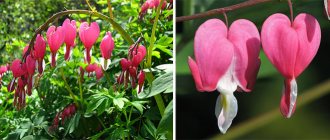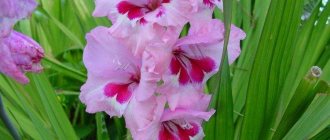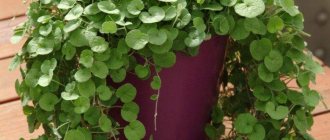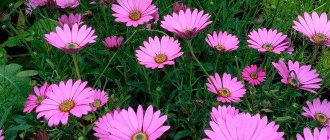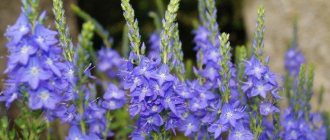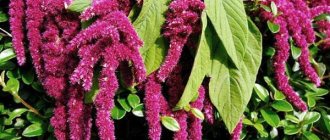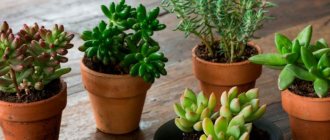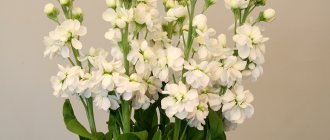The herbaceous perennial or annual plant Lamium is part of the Lamiaceae family. Under natural conditions, this plant can be found in Eastern Europe, and it prefers to grow along river banks. Outwardly, it looks like a simple low-growing weed. But as a result of the work of breeders, various cultivated ornamental varieties of jasmine have appeared, which can have different colors, stem heights and leaf shapes. The bush remains green and showy throughout spring and summer. Low-growing varieties are cultivated as ornamental ground cover plants, while tall perennial varieties are used to decorate ridges and flower beds.
Features of clear
Claryweed is characterized by very fast growth, which is why it looks very much like a simple weed. The maximum height of such a plant is about 0.25 m. Its root system is fibrous, and therefore it can very quickly fill a large area, decorating it with its branched stems. The dark green, heart-shaped leaves have a jagged edge. In the center of the leaves, soft veins are clearly visible; in some cases, the plate is decorated with spots.
Peduncles grow from internodes, and they can reach a length of about 0.3 m. They are overgrown with small leaf plates and flowers. The flowers can be painted in different colors; they have two-lipped corollas. In the center of each flower there are thin stamens with purple-black anthers. Flowers are collected in whorls. After the whorl withers, a seed capsule is formed in this place, and it contains triangular shaped nuts. This seed pod is the fruit of the jasmine. When the fruits are fully ripe, the seeds spill out of them on their own, thanks to which the plant reproduces well by self-sowing. Laminaria blooms for a very long time over several months. The first buds on peduncles are formed in the last weeks of spring, and the formation of fruits begins at the end of June.
How and when to collect
Purple lily (the herb will retain its medicinal properties if collected and prepared in time) is used as a medicinal plant. It is possible to collect leaves with flowers at almost any time, from May to September, since the crop blooms all summer. If there is a huge amount of grass, it is necessary to collect only the flowers, and if there is a shortage of it, also the foliage.
After collection, if the raw materials are clean, they should be placed in one layer in a ventilated room or under a canopy, avoiding direct sunlight. It is also permissible to dry the collected material in a dryer at a temperature not exceeding 40 °C.
The collected material will be ready after 15 days of drying. It should be stored in fabric or paper bags, as well as in jars. The container must be tightly sealed and stored at room temperature and moderate humidity.
You can store the dried leaves and flowers of the plant in a room with a cooler temperature, for example, in a niche or pantry. Under normal conditions and periodic inspection, the collected material can be stored for up to 2 years. If mold appears, the damaged part must be removed and the rest of the material must be moved to a drier place.
Growing from seeds
Sowing
Laminaria is propagated by seeds. It is recommended to sow them in late autumn or early spring, at which time seed germination increases significantly. The seeds are sown not for seedlings, but directly into the garden.
Before you start sowing, you need to prepare the site. To do this, dig up the soil and remove all weeds. Level the surface of the soil in the area and distribute the seeds evenly. When the seedlings grow a little, they can be thinned out if necessary. Caring for the seedlings is quite simple; they only need to be watered moderately in a timely manner, if there has been no rain for a long time. Do not allow the top layer of soil in the garden bed to dry out, but at the same time make sure that the liquid does not stagnate in the root system of the plants.
Most often, the grass does not need weeding, because it itself can suppress the growth of weeds, while it covers the area with a continuous carpet. However, perennial weeds, which have a very powerful root system, will have to be removed from the site.
Lamia, propagated by seed, blooms only in the second year after the seeds are sown. Experts advise not to allow uncontrolled self-seeding of this plant, because over time it can begin to suppress the development and growth of other crops growing in the garden and located nearby. If you decide to plant different varieties of claret, then choose areas for them located further away from each other. If they grow next to each other, this may have a negative impact on their decorativeness, because after cross-pollination there will be no varietal differences between them.
Speckled lily (spotted)
Use in folk medicine
The medicinal herb has been used in folk medicine for quite a long time in the form of tea, decoction and other forms. The course of therapy lasts on average 4–6 weeks. After this, take a break for 7–10 days and repeat the cycle. At the same time, you need to constantly monitor your well-being. If unpleasant symptoms occur, you should stop treatment and consult a doctor.
Tea
To prepare tea, take 2 tsp. raw purple clasp and pour a glass of water at room temperature. Then quickly bring to a boil and leave for 5-10 minutes. If possible, you can wait 30–40 minutes (cover with a ceramic lid). Then strain and drink the entire portion at one time. Take 2-3 glasses a day (before meals).
Purple clasp tea replenishes iron deficiency and strengthens blood vessels
Vitamin drink
The plant is also used as part of herbal preparations. For example, to prepare a vitamin-rich, tonic tea, take dried yarrow and jasmine flowers (a teaspoon each) and pour a glass of boiling water. Then infuse (at least 5 minutes) and take orally. There should be 2-3 such servings per day. You can add sugar or honey to improve the taste.
Water infusion
An aqueous infusion of purple clasp is prepared according to the following instructions:
- Take 2 tbsp. l. raw materials.
- Pour boiling water (1 cup).
- Infuse in a thermos or under a ceramic lid for an hour.
- Then filter.
- Take 2-3 tbsp. l. before meals.
Attention! This infusion is best used fresh, consumed 2-3 times a day. It can be stored in the refrigerator for 24 hours.
Decoction
Purple lily can also be used to prepare a decoction. To do this you need:
- Measure out 2 tbsp. l. flowers.
- Pour in 500 ml of boiling water.
- Simmer for 15–20 minutes in a water bath (close the lid).
- Cool and strain.
The decoction is useful for coughs, bronchitis and colds. It is taken 100 ml 3 times a day. The brewed amount (2 cups) is enough for the whole day. Then a fresh decoction is prepared.
For a water bath, take a container with a decoction of jasmine and place it in a pan of water, while the heat should be minimal
Alcohol tincture
Based on plant raw materials, you can prepare not only tea or water infusion, but also alcohol tincture. The instructions are as follows:
- Take 1 tablespoon of jasmine flowers (without leaves).
- Pour in 300 ml of vodka.
- Close the container.
- Place it in a dark and warm place for a week.
- Shake occasionally, turning up and down.
Then the tincture is filtered and used every day, 30 drops at a time. The general course of therapy lasts up to 1.5 months.
For external use
Water and alcohol infusions are consumed orally before meals. But for the treatment of skin diseases (wounds, inflammations, ulcers, eczema) external use is recommended. The best option is to take fresh herbs, chop them, put them on gauze and make a compress overnight or for several hours.
In winter, you can prepare a decoction of purpurea clasp and pour it onto gauze, and then apply it as a compress (to prevent it from spreading, you can press it on top with a plastic bag and wrap it with an elastic bandage).
Caring for claret in the open ground
Illumination
Such a herbaceous perennial plant as jasmine is unpretentious to grow. For her, it is best to choose areas that are in the lacy penumbra of tree crowns.
Priming
On the site, suitable soil for growing such a flower should be moist and loose, and it should contain a moderate amount of nutrients, including microelements. If the soil is overly fertile, this will lead to the rapid growth of damselfish, which may interfere with the normal growth and development of other flowering crops on the site.
Watering
Such a flower is watered systematically and abundantly, but make sure that water does not stagnate in the root system for a long time. During the dry period, the foliage dries out and curls, and shoots become exposed. Shortly before flowering begins, the plant should be fed with organic matter.
Trimming
Like other ornamental ground cover plants, jasmine should be systematically mowed. If this is done in a timely manner, then the flower will be able to maintain its spectacular appearance, as well as its bushiness.
Transfer
Adult bushes of perennial jasmine are replanted systematically, and this is done once every 5 years. This plant is highly resistant to frost, so it does not need additional shelter for the winter.
Spreading
Purple lily is widespread throughout Asia, Africa and throughout Europe. It can also be found in the European part of Russia and Siberia. The plant, which has medicinal properties, is unpretentious to soil mixtures and can grow well on calcareous or loamy soils that are saturated with moisture.
Grows easily in parks, along fences and other shaded areas.
Reproduction methods
Dividing the bush
Laminaria can be easily propagated by dividing the bush. This propagation method is very popular among gardeners, because bushes propagated in this way fully retain their varietal qualities, and they bloom the following year. It is recommended to divide the plant in spring. To do this, carefully dig up the bush and divide it into several parts, keeping in mind that each division must contain root shoots that can produce new shoots. After this, the divisions are planted in planting holes, which are prepared in advance. Don't forget to water them with plenty of water.
Layerings
Propagation of claret by layering is not very popular among gardeners. Most often, this procedure is carried out in the first autumn weeks. To do this, you need to select the most powerful shoots, bend them to the soil surface, fix them in this position and sprinkle them with a not very thick layer of soil. Next spring it will be possible to separate and plant the cuttings that have taken root from the mother plant, since by this time they will be able to grow normally on their own.
Cuttings
The plant can be propagated by cuttings in the last days of summer. To begin with, cuttings are prepared, which are planted in a mixture of sand and peat for rooting. They are covered on top with a cut plastic bottle or glass jar. The cuttings are provided with timely watering, and they also need to be ventilated as soon as condensation appears on the surface of the shelter. When the cuttings grow roots, they can be planted in a permanent place in the garden. Rooted cuttings require obligatory shelter for the winter; for this they are covered with spruce branches or flying leaves.
Diseases and pests
If you do not care for the jasmine correctly and allow regular stagnation of moisture in the root system, this will lead to the appearance of rot on it. In this regard, special attention should be paid to the condition of the soil on the site, and also do not forget to water the plant properly. All plants affected by rot are dug up and destroyed, and the areas in which they grew are treated with a fungicide solution.
The most common insects that harm the clearweed are scale insects, spider mites, and mealybugs. To get rid of these pests, you will need to treat the bushes with a suitable pesticide.
General tips and tricks
Difficulties that may arise during the cultivation of purpurea are listed in the following list:
- Despite the fact that the crop very rarely gets sick, simple waterlogging of the soil can be dangerous for it, which leads to rotting of the root system of the flower. A plant that has been severely damaged due to excess moisture can rarely be saved using various preparations and fungicides. As a result, the bushes will have to be completely dug out from the garden bed and burned away from other crops. Additionally, you will need to normalize the irrigation system so that the remaining plants do not get sick.
- If problems with rotting of the root system or stem were noticed in a timely manner, the affected plant must be removed from the garden bed, and the remaining specimens should be sprayed with special preparations that help stop the spread of the disease. It is recommended to use any product according to the instructions indicated on the packaging, so as not to overdo it with the dosage.
- Very often, spider mites live on purpurea. Traces of his presence can be identified by the presence of a silvery web, which spreads like an invisible carpet on the perennial. To get rid of the problem, the crop needs to be treated with acaricides.
- In rare cases, the plant is attacked by scale insects, whiteflies and scale insects. If this happens, insects can cause significant harm to the crop. You can get rid of them by using powerful systemic insecticides.
Purple lily is considered a valuable medicinal plant that can be used for preventive purposes for various diseases. In the treatment of certain pathologies, the herb is used as part of a complex therapeutic treatment, since it has anti-inflammatory, expectorant and astringent properties. The treatment course should last no more than 30 days. However, before using the plant, you should consult a doctor.
Yasnotka in landscape design
Among gardeners, the most popular varieties are variegated varieties. They are cultivated as decorative landscaping in free areas or grown in flower beds as separate decorative groups. This plant is best planted near hosta, lungwort and heuchera. Terraces, gazebos and balconies are often decorated with clear flowers. They can also be grown as an hanging plant.
Use in the garden
Yasnotka is very popular in landscape design. The variegated forms are of greatest interest. They are used in mixborders, rockeries and for landscaping space under trees. The best neighbors for clears are heucheras, lungworts, hostas, and tiarellas.
The plant can be grown not only in open ground, but also in flowerpots, tubs or in ordinary pots for the home. The flower will look very impressive indoors, and long strands can be hung over the edge.
Types and varieties of chrysanthemums with photos
Today, there are approximately 25 species of such a garden perennial plant as damselfish. Below we will describe those that are most popular among gardeners:
White nettle or dead nettle
This herbaceous perennial can reach a height of about 0.45 m. The surface of the shoots and foliage is rough to the touch. The oval-elongated leaf plates are painted in a greenish tint, their edges are jagged. They are attached to the shoot by short petioles. Flowering begins in June, and it ends only in the last days of September. The flowers are painted white.
Purple nettle or red nettle
In the garden, this species is cultivated as a biennial or annual plant. The length of the shoots is about 0.25 m, they are densely covered with very small oval leaf plates with a dark green color. The formation of buds begins in the middle of spring, but in general this plant blooms for several months.
Spotted or speckled lily
This is a tall herbaceous plant that has highly branched stems. The green foliage is decorated with veins of a silvery hue. Pale pink flowers can be seen on bushes during the flowering period from May to October. The best varieties:
- Album - snow-white flower color;
- Beacon Silver - foliage is painted in an unusual silver shade;
- Aureum - the color of the flowers is purple and the foliage is yellow.
Greenweed, or yellow
Unlike other species, the creeping stems and foliage of this plant are pubescent. The shape of the leaf plates is elongated-oval, sometimes their surface is decorated with a marble mesh. The appearance of yellow flowers on the shoots is observed in the first days of May. During the season, the bushes may bloom again. The best varieties:
- Argentatum - stripes are located on the surface of wide green leaf plates;
- Silver Carpet - oblong foliage is decorated with a pattern of a silver shade.
Warbler's eagle
When this low-growing plant blooms, small, rich pink flowers form on it. Flowering duration is about 2 months (May–June).
Description of the plant
Purple lily (the medicinal properties of the plant are presented in the article for informational purposes) is a biennial crop, but some species can also be annual. The growth of the plant can reach 30 cm, the stems are creeping, climbing, green in color with a reddish tint.
The purple leaves have a large number of veins and are covered with small hairs on top. The flowers are located in the axils and have a different color palette from pink to white and purple. The plant blooms for a very long time, from April to October.
The herb is widely used in folk medicine, since decoctions prepared on its basis can treat various diseases. The plant is used to make various herbal cocktails, as a filling for baked goods, added to vitamin-rich salads, and used to prepare green borscht.
When designing landscape design, the ground cover properties of the plant are used. They can beautify borders and decorate the ground parts of bushes. The culture will also help in landscaping unsightly areas that are shaded by buildings or fences.
Due to its ability to grow on rocky terrain, it can be used to decorate alpine slides. In flowerpots, grass moves its stems down very effectively.
Daffodils, hyacinths, tulips or dwarf crops will feel good as neighbors next to the plant. Taller flowerbed partners include ferns, hostas and lungworts.
Medicinal properties of jasmine
Larva is a medicinal plant. Its healing properties are due to the content of a large number of useful substances, the most important of which are: alkaloids, flavonoids, essential oils, ascorbic acid and tannins.
Infusions based on this plant are used for sore throats, serious inflammations, or as a diuretic. In order for open wounds to heal faster, herbal lotions are applied to them. Hot baths with jasmine help with gynecological diseases.
Before using jasmine as a medicinal plant for the first time, it is recommended to consult with your doctor. There are practically no contraindications to the use of yasna. However, individual intolerance to the substances included in the composition of jasmine is rare, which can cause the development of allergic reactions.
CLARITY || Useful properties and applications
What does the plant look like?
Lamiaceae grass belongs to the Lamiaceae family. There are more than 3,500 varieties. There are about 30 species. They are distinguished by the colors of their buds and the shape of their leaves. A distinctive feature of these plants from other representatives of the flora is their two-lipped flowers. There are five petals below, they are completely fused. From above, the petals grow together in parts.
What does it look like
The stem has four sides. There are several leaves growing on it. The roots have a creeping appearance. The stems reach a height of 15-45 cm. Flowers bloom from May to September.
Medicinal properties
Yasnotka is not included in the Russian Pharmacopoeia. However, its properties are subject to active research. It has been scientifically proven that claspberry-based products are used as a hemostatic, anti-inflammatory and hypotensive.
Important! The beneficial qualities of the plant in question are related to its chemical properties.
Clarity contains tannins. They have astringent properties, which helps the skin cleanse itself of various inflammations: hives, eczema, etc. There is also mucus in the plant cells. This is an excellent substance as an expectorant. The presence of flavonoids helps strengthen capillary walls and lower blood pressure.
No harmful substances were detected. The use of medications with it is prohibited if there is increased blood clotting and chronic hypotension. An absolute contraindication to taking this plant during pregnancy, as it increases the likelihood of miscarriage.
Brief history of appearance
The homeland of jasmine is Europe, Asia and North Africa. Many species grow throughout the world as weeds that plague agriculture. However, some species are used as ornamental plants.
The name "Lamium" was coined by the philosopher Pliny. He made several assumptions about the origin of this name:
- from Greek “Laimos” is translated as “mouth-throat”;
- another translation option is “large cavity”;
- Lamia is the name of a Libyan queen. She is listed in history as a monster who ate her own children. The lily also swallows a bumblebee or a bee that has landed on a flower for nectar.
Despite its similarity to nettle, it does not burn and has soft stems. However, the plant has a very heavy and foul odor. This may have something to do with keeping animals away from you. Cattle also do not eat this grass. In addition, it resembles nettles. The plant is widespread in forests, meadows, shady areas, near fences.
An excerpt characterizing Purple Lami
The doctor promised to get it and began asking the prince about how he felt. Prince Andrei reluctantly, but wisely answered all the doctor’s questions and then said that he needed to put a cushion on him, otherwise it would be awkward and very painful. The doctor and the valet lifted the greatcoat with which he was covered and, wincing at the heavy smell of rotten meat spreading from the wound, began to examine this terrible place. The doctor was very dissatisfied with something, changed something differently, turned the wounded man over so that he groaned again and, from the pain while turning, again lost consciousness and began to rave. He kept talking about getting this book for him as soon as possible and putting it there. - And what does it cost you! - he said. “I don’t have it, please take it out and put it in for a minute,” he said in a pitiful voice. The doctor went out into the hallway to wash his hands. “Ah, shameless, really,” the doctor said to the valet, who was pouring water on his hands. “I just didn’t watch it for a minute.” After all, you put it directly on the wound. It’s such a pain that I’m surprised how he endures it. “It seems we set it up, Lord Jesus Christ,” said the valet. For the first time, Prince Andrei understood where he was and what had happened to him, and remembered that he had been wounded and how at that moment when the carriage stopped in Mytishchi, he asked to go to the hut. Confused again from pain, he came to his senses another time in the hut, when he was drinking tea, and then again, repeating in his memory everything that had happened to him, he most vividly imagined that moment at the dressing station when, at the sight of the suffering of a person he did not love, , these new thoughts came to him, promising him happiness. And these thoughts, although unclear and indefinite, now again took possession of his soul. He remembered that he now had new happiness and that this happiness had something in common with the Gospel. That's why he asked for the Gospel. But the bad situation that his wound had given him, the new upheaval, again confused his thoughts, and for the third time he woke up to life in the complete silence of the night. Everyone was sleeping around him. A cricket screamed through the entryway, someone was shouting and singing on the street, cockroaches rustled on the table and icons, in the autumn a thick fly beat on his headboard and near the tallow candle, which had burned like a large mushroom and stood next to him. His soul was not in a normal state. A healthy person usually thinks, feels and remembers simultaneously about a countless number of objects, but he has the power and strength, having chosen one series of thoughts or phenomena, to focus all his attention on this series of phenomena. A healthy person, in a moment of deepest thought, breaks away to say a polite word to the person who has entered, and again returns to his thoughts. The soul of Prince Andrei was not in a normal state in this regard. All the forces of his soul were more active, clearer than ever, but they acted outside of his will. The most diverse thoughts and ideas simultaneously possessed him. Sometimes his thought suddenly began to work, and with such strength, clarity and depth with which it had never been able to act in a healthy state; but suddenly, in the middle of her work, she broke off, was replaced by some unexpected idea, and there was no strength to return to it.
Description of varieties - common features and differences
Speckled lily - planting and care
All species are divided into several groups: annual, biennial and perennial clears. The most common are the following.
Purple lily
Other names: pink claret, purple clasp.
Brief description: lives 1-2 years, green leaves, pink, white, purple flowers. In open ground it reproduces by dividing the bush. Blooms from mid-spring to early autumn.
Purple lily
Spotted lily (speckled)
Latin name: Lamium Maculatum. The flowers are pink or light purple. They are quite large, 2-3 cm. They bloom from early May to mid-autumn. The leaves are small, dark green.
This species is a perennial with several varieties:
- Bekon Silver – Silver is characterized by purple or ash flowers combined with silvery leaves. Its other name is silver claret.
- Golden Anniversary - Gold Anniversary grows up to 20 cm. Its leaves are bright green with a light stripe in the middle.
- Purple Dragon - Dragon is characterized by a pinkish-purple color of its petals.
- Nancy White - Nancy White has silvery leaves and white flowers.
Planting and caring for any of the listed varieties is not difficult.
Yellow lily
Another name is zelenchukova (Yellow, Luteum). The flowers are yellow, whorled. The life form is a herbaceous perennial. This Pride variety is used for decorative purposes.
Variegated Lariat
This is a perennial, the petals are yellow, and yellow spots are located in a chaotic manner on the green leaves.
Tomentose yasnotka
A perennial plant with wrinkled, ovate leaves; there are serrations along the edges of the leaves, which gives them an even greater resemblance to nettle leaves.
Interesting! Flower growers most prefer to grow different varieties of variegated leaves in their garden plots in the open ground.
Diseases and pests
The culture has good resistance to most diseases and pests. As a result of severe waterlogging, it may suffer from rot. Such plants look clearly sick; foreign spots and dots appear on the surface of the leaves. They need to be dug up and rotten roots and foliage removed. Then the bush is planted back and it and neighboring plants are treated with fungicides: Bordeaux mixture, Fitosporin, Fundazol, Skor, Ordan, Tattu.
Of the insects, mealybugs, scale insects and spider mites can cause particular harm to the plant. When they are detected, the bushes are treated with insecticides: Fufanon, Fitosporin, Vertimek, Aktara, Decis, Konfidor.
You can also use folk remedies - a decoction of marigold flowers, a solution of wood ash with soap, an infusion of tobacco dust, garlic cloves, chili peppers and others.


